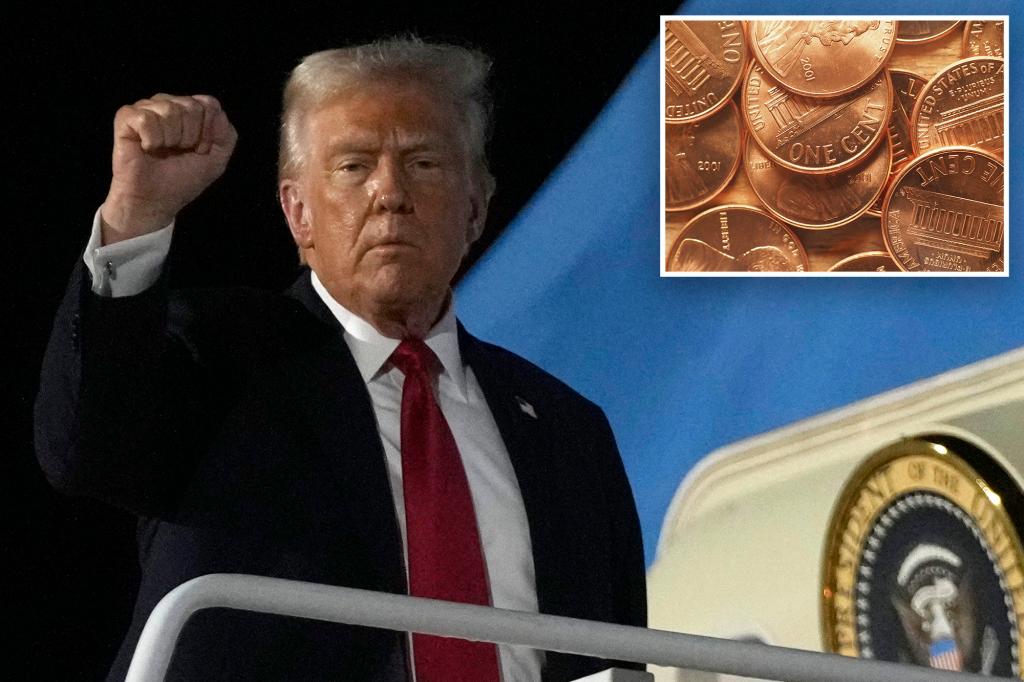World
Trump announces he’s instructing Treasury Department to stop producing the penny: ‘This is so wasteful!’

President Trump’s Bold Move to Eliminate the Penny: A Cost-Cutting Initiative
In a surprise announcement on Sunday night, President Trump revealed a significant cost-cutting measure aimed at reducing financial waste within the federal government. The President declared that he has instructed the Department of the Treasury to halt the production of new pennies, citing the escalating costs of minting the one-cent coin. This move comes as part of a broader effort by the Trump administration, supported by billionaire entrepreneur Elon Musk, to identify and eliminate unnecessary expenditures across federal agencies.
The Financial Burden of the Penny: A Growing Concern
The decision to stop producing pennies is rooted in the stark reality that manufacturing these coins has become a costly endeavor. According to recent data, the production of a single penny now exceeds three cents, a figure that has been steadily rising over the years. In fiscal year 2023 alone, the U.S. Mint produced over 4.5 billion pennies, accounting for approximately 40% of all coins minted for circulation. This staggering volume, combined with the high production costs, resulted in a financial burden of over $179 million for taxpayers in the same year. The penny, which is primarily composed of zinc with a thin copper overlay, has seen its production costs balloon to 3.07 cents per coin in 2024. These numbers underscore the economic inefficiency of continuing to mint pennies, a point repeatedly emphasized by President Trump and his administration.
Historical Attempts to Phase Out the Penny: A Long-Standing Debate
President Trump’s decision to stop producing pennies is not the first time the idea of discontinuing the one-cent coin has been raised. Over the past few decades, there have been several attempts by lawmakers to address the financial inefficiency of the penny. One notable example was in 1990, when former Representative Jim Kolbe (R-Arizona) introduced legislation that sought to eliminate pennies from all transactions, proposing instead to round monetary amounts to the nearest nickel. Although this bill failed to gain traction, it marked one of the earliest formal efforts to reconsider the role of the penny in American currency.
Similarly, the late Senator John McCain (R-Arizona) attempted to advance a measure that would have halted the minting of pennies for a decade, with the aim of studying whether their removal from circulation was feasible. Unfortunately, this proposal also fell short of becoming law. Despite these past failures, the debate over the penny’s continued relevance has persisted, with many advocating for its elimination as a means of reducing waste and streamlining the U.S. currency system. Trump’s announcement has thus reignited this long-standing conversation, bringing it back into the national spotlight.
Public Sentiment and the Practical Implications of Ending Penny Production
The question of whether the penny should continue to be minted is not solely a matter of economic calculation; it also touches on cultural and practical considerations. A 2022 poll revealed that 58% of U.S. voters supported the idea of stopping penny production, indicating a significant shift in public opinion in recent years. This growing support for phasing out the penny may be attributed to a heightened awareness of the financial burden it imposes, as well as the increasing digitization of monetary transactions, which has reduced the practical need for physical cash.
However, the elimination of the penny is not without its challenges. For instance, rounding transactions to the nearest nickel could have unintended consequences, such as price inflation for certain goods and services. Moreover, pennies hold a certain sentimental value for many Americans, who view them as a symbol of thriftiness and financial prudence. These factors highlight the complexity of the issue, as policymakers must weigh the financial benefits of discontinuing the penny against its cultural and practical significance.
The Economic and Cultural Significance of the Penny: A Symbol of Frugality
The penny, first introduced in 1793, has long been an iconic symbol of American currency and frugality. Its image, featuring Abraham Lincoln, has made it a beloved and recognizable coin both domestically and internationally. However, as the U.S. Mint continues to produce billions of pennies each year, the practicality of maintaining such a low-denomination coin has come under increasing scrutiny. While the penny remains a cherished part of American culture, its economic viability has become a subject of debate among policymakers and economists.
From an economic standpoint, the argument for discontinuing the penny is compelling. The cost of producing and distributing pennies far outweighs their face value, making them a costly burden on taxpayers. Additionally, the rise of digital payment systems has reduced the reliance on physical currency, further diminishing the need for pennies in everyday transactions. These factors have led many to conclude that the penny’s continued production is no longer justified, either economically or practically.
The Broader Implications of Trump’s Penny Plan: Leadership and Fiscal Responsibility
President Trump’s decision to stop producing pennies is part of a larger effort to root out inefficiency and waste within the federal government. This initiative, supported by entrepreneur Elon Musk and the Department of Government Efficiency, reflects the administration’s commitment to fiscal responsibility and cost-cutting measures. By targeting the penny, a symbol of financial waste, Trump is sending a clear message about his intent to address even the most seemingly insignificant expenses in the federal budget.
In conclusion, the announcement to halt penny production represents a bold step in the Trump administration’s efforts to curtail unnecessary spending. While the decision has sparked debate over the penny’s cultural and practical significance, the financial arguments in favor of discontinuing its production are formidable. As the U.S. government continues to grapple with fiscal challenges, this move underscores the importance of reevaluating long-standing practices and embracing innovative solutions to reduce waste and enhance efficiency. Whether the penny will ultimately disappear from circulation remains to be seen, but one thing is clear: President Trump’s initiative has brought this issue to the forefront of the national conversation, ensuring that it will be a topic of discussion for years to come.
-

 Australia13 hours ago
Australia13 hours agoCyclone Zelia WA category 5 storm to hit Pilbara region near Karratha and Port Hedland
-

 Money3 days ago
Money3 days agoConsumer Financial Protection Bureau Adds Error Message To Home Page
-

 Canada19 hours ago
Canada19 hours agoWork underway to twin Calgary feeder main that caused water crisis
-

 Money3 days ago
Money3 days agoWinning Content Strategies For Wealth Managers
-

 Australia1 day ago
Australia1 day agoTropical Cyclone Zelia intensifies to category 2 storm
-

 Asia1 day ago
Asia1 day agoWhat you need to know about 2024 YR4, the asteroid that could hit Earth in about eight years’ time
-

 Entertainment1 day ago
Entertainment1 day agoPrince Harry and Meghan Markle’s Best Moments and Photos From the 2025 Invictus Games
-

 Australia22 hours ago
Australia22 hours agoTropical Cyclone Zelia intensifies to category five system off Pilbara coast











